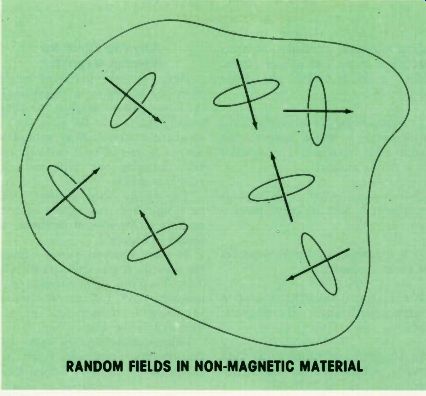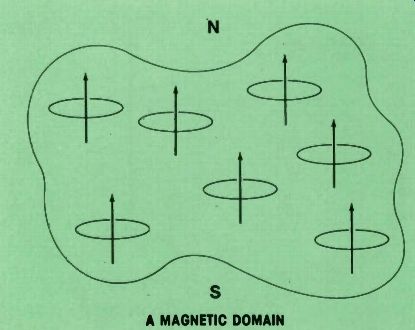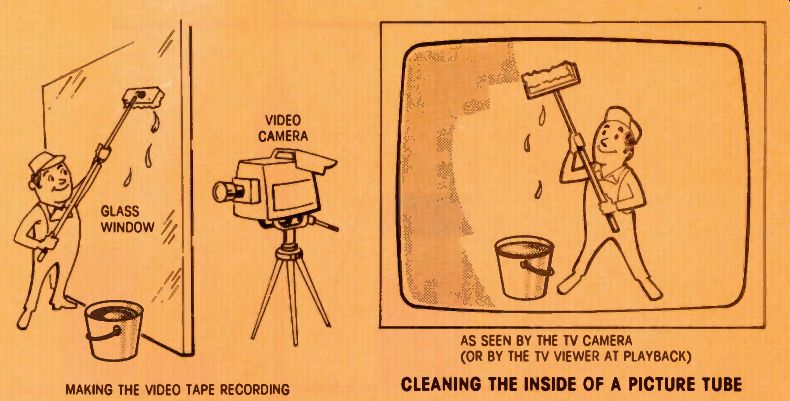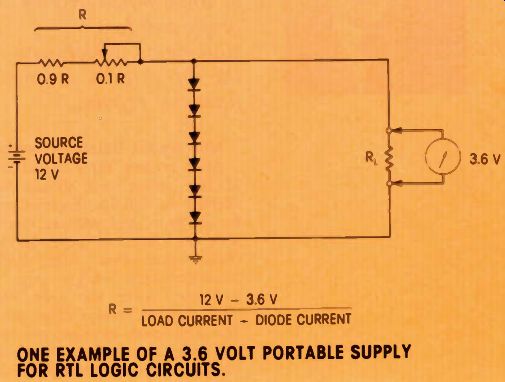

By J.A. "Sam" Wilson, CET
-----------
Sam Wilson's monthly "Technical Notebook" will present a variety of subjects and ideas.
Sam has strong opinions, and possibly some will provoke conversation and controversy.
The ideas and opinions of this column are not necessarily those of the editor or other employees of Electronic Servicing.
Your letters are welcome, so long as you give us permission to quote from them. Address all letters to:
J. A. "Sam" Wilson c/o Electronic Servicing.
P.O. Box 12901 Overland Park, Kansas 66212
-------------
No One Fixes Magnets
Electronic systems have many magnets and electromagnets. There fore, the study of magnetism is appropriate for technicians. Deflection yokes, for example, work by electromagnetic attraction.
Seldom do the schools spend much time studying magnetic phenomena, so consider this as a postgraduate course.
I'm certain to receive some letters saying that technicians really don't need to know anything about magnetism, because no one can repair magnets. Well, doctors can't "fix" a human liver either, but they still study about them in medical school.
What Do You Know About Magnetism?
Here is a short quiz to determine how much (or how little) you know about magnetic principles. Answers are given at the end of this article.
Mark "true" or "false" after these statements:
(1) Ferromagnetic materials are attracted to a strong magnet, but some other materials are repelled by a strong magnet.
(2) It is possible for a gas (such as hydrogen) to have magnetic properties.
(3) A magnetic bubble is a pocket of air in a magnet.
(4) A magnetic amplifier is used to increase the strength of a magnetic field.
(5) According to history, the first known practical use for magnetism was in the year of 2637 B.C.
Why Are There No Wooden Magnets?
Have you ever wondered why a piece of wood can't be magnetized? A kindergarten teacher probably would explain that the wood isn't a magnetic material. That redundant answer is just a stall to keep you from bugging her until you can read this article.
The reason some materials can be magnetized and others can't is because of' the spin of electrons, as shown in Figure 1.
As each electron moves around the nucleus, it also spins on its axis.
This electron spin produces a magnetic field, and the direction of the field is determined by the direction of the spin.
In most materials, the spins and the resulting magnetic fields are compensated. In other words, there are as many electron spins in clock wise direction as there are spins in counterclockwise direction. So, the magnetic fields cancel, leaving no net external magnetic field.
A few materials (such as iron, nickel, and cobalt) have spins that do not cancel completely. Some uncompensated spins produce a resultant magnetic field. Incident ally, to make the material magnetic, the uncompensated spins must be in an inner orbit. Therefore, each molecule of iron behaves as a tiny magnet.
RANDOM FIELDS IN NON-MAGNETIC MATERIAL

Figure 2
A MAGNETIC DOMAIN

Figure 3
Every particle in an atom is believed to have a spin and a resultant magnetic field, but the electron spin produces the magnetic effect in iron and other ferromagnetic materials. Some magnetic de vices have been designed to use proton spins. We'll discuss those at a later time.
By itself, the uncompensated electron spin can't account for the total magnetic properties of ferro magnetic materials. The crystalline structure of the iron also is an important factor. The atoms (or molecules) in the crystal have uncompensated spins that tend to lock their magnetic fields into a single pattern called a "domain." Let me phrase that another way.
A single molecule or atom in a magnetic material acts as a very tiny magnet. When that atom is in a crystal, its field adds to the fields of other atoms in the crystal. These combined fields produce a strong localized field. That's what makes up a domain.
Figure 2 illustrates how the electron magnetic fields of an unmagnetized material have no result ant field. Uncompensated spins produce tiny magnetic fields which are represented by arrows. When the arrows point in random directions, there is no net field.
In the domain of Figure 3, all magnetic fluxes of each atom combine with the magnetic flux of the other atoms to produce a net north/south field for the domain.
About 1,000,000,000,000,000 atoms are in a domain (count them, if you doubt!), and each domain has a volume of 0.000000001 centimeters.
Although the domain size is very small, you can see them under a microscope. In unmagnetized iron, each little domain and its associated field is pointed in a different direction at random.
Now, when the iron is magnetized, each domain turns around and lines up with the others to produce a net magnetic field for the iron.
The relationship between a magnetized and an unmagnetized piece of material usually is illustrated as shown in Figure 4. Each tiny magnet represents a domain. Unmagnetized material has the do mains in a random pattern, while magnetized material has all of the domains aligned in the same direction to produce a net magnetic field. There are a great number of domains in each piece of iron. Remember, the illustration is only a model.
Proof of Domains
The following simple experiment demonstrates the existence of do mains. When a magnetic field is near a magnetic material, the material becomes magnetized.
Stronger magnetic fields produce stronger magnetism. Figure 5 shows a characteristic curve of magnetizing force versus magnetism.
Although this curve appears to be smooth, it actually is made up of small steps. If you expand the curve by increasing the gain of a scope, you can see these steps. Or, as shown in Figure 5, a curve having sufficient fine detail could be magnified by a reading glass.
(Sometimes, this is called the "Barkhausen Experiment.") These small steps represent do mains turning into alignment as the magnetizing force is increased.
In fact, by using the experiment al setup of Figure 6, you can hear the domains turning into position.

Figure 4 -- DOMAINS MOVE INTO THE SAME ALIGNMENT, WHEN THE MATERIAL IS MAGNETIZED

Fig. 5

Figure 3 -- MAGNETISM CHANGES IN SMALL STEPS
Why "Johnny" Can't Understand Magnetics
Two serious problems for teaching or understanding magnetics are multiple measurement systems, and an unfortunate tendency to compare the similarities of magnetics and electronics.
Too many standards
Progress in any technical field is dependent upon the ability to make measurements. Unfortunately, there are a number of different systems of measuring magnetics. Any at tempt to learn about magnetics by mastering all of these systems probably would flounder on the excessive math necessary for converting from one system to another.
A better way is to specialize in only one system. Then you can use a conversion, if you ever need to work with another system. Through out this series, we will use only MKS units.
Forget Ohm's law
I believe it is more confusing than helpful to teach magnetics by making direct comparisons with electrical circuits. The differences outweigh the similarities.
For example, Table 1 lists some differences between magnetic systems and electrical systems.
Also, look at the so-called "Ohm's law for magnetic circuits" in Table 2. This equation causes more misunderstandings than it clarifies. The electronic Ohm's law is accurate only in circuits where the resistances are linear. But, with magnetism, the material almost always is non-linear. To solve non-linear math, a load line (or other method) must be used. So, the Ohm's law formula for magnetic circuits works ONLY in very rare cases.
Next month, I'll attack head-on the confusion of magnetic units and measurements. This will be the foundation for future articles about practical applications of magnetics.
Pleasing Critical Customers
I've been accused occasionally of having an overactive imagination, so I'm always glad to blame...er... ah, credit someone else when I report something that seems a bit ridiculous. So, I'm happy to say this next idea came from John Witkoski, a well-known technician and radio amateur in the Warren, Ohio, area.
Every TV technician has had customers who refuse to be satisfied with the TV performance, even when the picture is perfect. Witkoski's idea is to use a videotape recorder as a psychological gimmick.
The first step is to make a video tape recording of someone washing a dirty window (perhaps your shop window), as shown in Figure 7.
When a customer is impossible to please, tell him/her that you will have the inside of the picture tube cleaned to improve the picture. Play the tape in a VTR connected to the TV and allow the customer to watch a realistic view of a tiny man washing the TV screen.
If you have a color camera, show cleaning of each color separately.
You might even have the technician picture-cleaner pick up "dirty" electrons (rubber balls) and place them in a container. Perhaps you can think of other variations.
I don't know what you should tell a customer who calls you later to complain that you missed a spot! (Or perhaps, what you should tell the judge at your trial.) Witkoski passed along this idea, but he doesn't use it himself. You see, he doesn't have that kind of customer.

-- Fig. 6 WHEN MAGNETISM IS BEING CHANGED, THE SOUND OF DOMAINS ALIGNING
CAN BE HEARD.
-----------------
Table 1 Differences Between Magnetic And Electronic Systems
Magnetic flux often is said to be comparable to current in an electric circuit, BUT... current flows through a circuit, while magnetic flux does NOT move through a magnetic circuit
Further, current is confined t the conducting path, but some flux can "leak" from a magnetic circuit.
Magnetomotive force (MMF) often is compared with electro motive force (EMF), BUT... neither MMF nor EMF is a force. Both are units of work.
Reluctance always has an ac companying magnetic field, BUT... resistance often is linear i electric circuits, while reluctance almost never is linear.
Current always has an accompanying magnetic field, BUT... a magnetic field is not always accompanied by an electric current.
Current through a wire produces heat, BUT... flux through an iron core does not produce heat.
----------------
Table 2 Ohm's Law For Magnetic Circuits
0 = MMF
(where 0 is the flux, MMF is the magnetomotive force that produces the flux, and R is the reluctance, or opposition to the flux)
-------------------

Figure 7A; Figure 7B

Figure 8
Low-Voltage Regulated Power Supplies
Once, I nominated RTL and TTL digital logic as the klutzie idea of the month, because of the weird supply voltages. RTL requires 3.6 volts, and TTL needs 5 volts. This presents problems for portable battery-operated circuits. I received some flack about my criticism.
Since then, I have thought about the problem. Mercury cells have a terminal voltage of 1.2 volts each, after the initial discharge time.
Three in series would work well for 3.6 volts, and four gives 4.8 volts, which is near enough to make TTL circuits work okay.
Alternately, a higher battery voltage can be reduced and regulated by a simple circuit (see Figure 8). The forward-biased silicon diodes will give about 0.6 volt drop across each. Six diodes should give about 3.6 volts. The variable resistance allows adjustment to offset battery weakening, and it allows some choice of output voltage.
Okay, critics, stop the protest letters.
Sam says: I need back issues of the original Technical Notebook that was sent to ISCET members. Also, I would appreciate receiving any back issues of Electronics or EED.
Answers to the Magnetics Quiz
(1) True. All materials can be categorized as: ferromagnetic (materials that are attracted to a strong magnetic field); paramagnetic (materials that have virtually no magnetic properties); or diamagnetic (materials such as hydrogen, copper, and silver which are repelled by a strong magnetic field).
(2) True. In the answer for #1, I listed hydrogen as diamagnetic. Other gases have magnetic proper ties. In fact, a sensitive measuring instrument (called a nuclear procession magnetometer) uses the work by controlling the flux of specially-designed transformers, magnetic properties of a gas to detect changes of magnetic field strength. It has been used in air craft to locate buried iron-ore deposits.
(3) False. A magnetic bubble isn't a bubble at all. It is a tiny cylinder shaped domain of magnetic intensity. These so-called bubbles are used in computer bubble-memories.
(4) False. Magnetic amplifiers are used to control the amount of AC power delivered to a load. They work by controlling the flux of specially-designed transformers.
(5) True. The emperor of China (it is said) was chasing a rebel prince in 2637 B.C. He and his gunsels became lost in a heavy fog, and couldn't locate the rebel. The emperor built a crude compass that always pointed south. By using the compass, the emperor and his staff found their way out of the fog and caught the bad guy. This is the first record of a practical magnetic device.
(adapted from: Electronic Servicing magazine, Apr. 1978)
Next:
Also see: